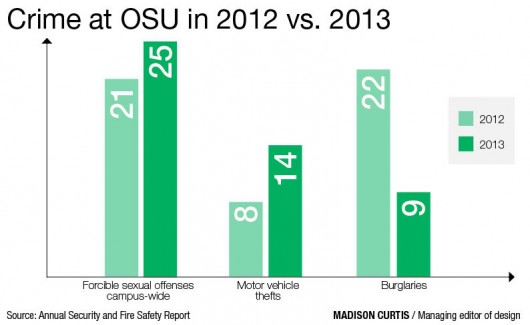Ohio State’s annual crime report isn’t simply an update on last year’s — it’s been expanded to include additional information on crimes reported on campus. Domestic violence, dating violence and stalking are all included on the report in response to changes to a federal act.
OSU is required by law to publish the report, which was released earlier this week. And while reports of some crimes rose and others decreased, some students had mixed reactions about how safe they feel on campus.
The report compiles crime data on and around campus to comply with the Clery Act. The act requires colleges and universities to disclose information about crime on and around campus spaces, and was designed to make college campus crime information readily available.
The 2014 report includes crime statistics from University Police, Student Life, the Columbus Division of Police and other university offices and departments, as well as various police agencies.
No formal police report is needed for an offense to be included in the report’s statistics, University Police Chief Paul Denton said.
As for the new crime categories listed, there were three incidents of domestic violence, seven incidents of dating violence and three incidents of stalking.
Denton said those categories were added to comply with changes to the Violence Against Women Act, which was passed in 1994 to help combat violence against women.
Offenses like motor vehicle theft and sexual assault on campus increased in 2013 from 2012, but others, like drug law violation arrests and burglary, dropped.
The number of forcible sexual offenses on campus that didn’t occur in residence halls doubled in 2013 from 2012. That number went to 14 in 2013 from seven in 2012, according to the report. There were nine reported in 2011.
Denton said of those 2013 offenses, six reportedly occurred at the OSU Wexner Medical Center; two at Mirror Lake; one at Ohio Stadium; one at Thompson Library; one at Curl Drive and Peasley Street; and one at College Road and 12th Avenue.
Denton said these offenses didn’t necessarily take place inside the named buildings, like Thompson Library, but could have taken place outside. He also said the Mirror Lake offenses didn’t seem to have occurred on Mirror Lake jump night, when students annually jump into the lake before the OSU-Michigan game.
He said the increased number of forcible sex offenses reported could be attributed to several factors.
“The Ohio State University continues to focus on training and education, improving our reporting process and increasing awareness of issues related to sexual violence, which is leading to increased reporting of these offenses,” Denton said in a Tuesday email.
Overall, there were 25 reports of forced sexual offenses campus-wide in 2013, the report said. Eleven of those occurred in residence halls. The campus total in 2012 was 21, with 14 having occurred in residence halls.
Motor vehicle thefts also increased in 2013 from 2012. There were 14 motor vehicle thefts reported in 2013, while 2012 and 2011 saw eight car thefts each.
Meanwhile, drug law violations decreased more than 28 percent in 2013 from 2012. 2013 saw 48 drug violations end in arrests on campus, while there were 67 in 2012.
There were also nine burglaries reported in 2013, down from 22 the year before.
But some students were split on whether or not they feel campus is safe.
Rebecca Izzi, a fourth-year in strategic communication and political science, said although she feels safe on campus during the day, her attitude changes once the sun goes down.
“I’m definitely not about to walk to the library at night,” she said. “Especially last year when that person got robbed at gunpoint by Smith Lab.”
A public safety notice was issued by University Police in April after a female student was approached by three men, one of whom pointed a gun at her and another who stepped behind her to put his hand over her mouth and pat her down. The incident occurred on West 18th Avenue between McPherson and Smith laboratories. The robbery was interrupted and the three men ran northbound away from campus, according to the notice.
Others, like Eric Shea, a first-year in chemical engineering, said he feels reasonably secure on campus.
“There’s not too much (crime). There’s cops everywhere that I see all the time,” he said.
Rachelle Barr, a fourth-year in public health, said even though she feels safe on campus, she feels the biggest threat to her safety is people making irresponsible decisions.
“With people being drunk (on the weekends), it’s just somebody doing something stupid and not thinking about the consequences before they do it,” she said.
Ingrid Gardner and Paul Ellis contributed to this story.



